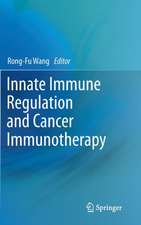Histopathology of Nodal and Extranodal Non-Hodgkin’s Lymphomas
M. Paulli Autor Alfred C. Feller A. Le Tourneau Autor Jacques Diebolden Limba Engleză Paperback – 19 aug 2012
| Toate formatele și edițiile | Preț | Express |
|---|---|---|
| Paperback (1) | 738.94 lei 39-44 zile | |
| Springer Berlin, Heidelberg – 19 aug 2012 | 738.94 lei 39-44 zile | |
| Hardback (1) | 1125.68 lei 6-8 săpt. | |
| Springer Berlin, Heidelberg – 20 noi 2003 | 1125.68 lei 6-8 săpt. |
Preț: 738.94 lei
Preț vechi: 777.83 lei
-5% Nou
141.40€ • 147.34$ • 117.08£
Carte tipărită la comandă
Livrare economică 31 martie-05 aprilie
Specificații
ISBN-10: 3642622240
Pagini: 444
Ilustrații: XII, 428 p.
Dimensiuni: 193 x 242 x 23 mm
Ediția:3rd ed. 2004. Softcover reprint of the original 3rd ed. 2004
Editura: Springer Berlin, Heidelberg
Colecția Springer
Locul publicării:Berlin, Heidelberg, Germany
Public țintă
Professional/practitionerCuprins
1 History of Lymphoma Classification.- 1.1 Introduction.- 1.2 The Kiel Classification.- 1.3 The REAL Classification Proposal.- 1.4 The WHO Classification.- References.- 2 Current Status of Lymphoma Classification.- 2.1 Introduction.- 2.2 Small- and Large-Cell Versus Low- and High-Grade.- 2.3 Primary Versus Secondary Lymphoma.- 2.4 Definition of Immunocytoma and Its Border with Marginal Zone B-Cell Lymphoma.- 2.5 Indistinct Border Between Nodal Marginal Zone B-Cell Lymphoma and Follicular Lymphoma with Marginal Zone Differentiation.- 2.6 Grading of Follicular Lymphoma.- 2.7 Distinction Between Diffuse Large B-Cell Lymphoma and Burkit’s Lymphoma: Reproducibility and Value of Subclassification.- 2.8 Problems in Reproducibly Recognizing Anaplastic Large-Cell Lymphoma and Lymphoblastic Lymphoma on Purely Morphological Grounds.- 2.9 Is Peripheral T-Cell Lymphoma, Unspecified a Distinct Clinicopathological Entity or a Catchall Term?.- 2.10 Neither the WHO nor the EORTC Classification of Cutaneous Lymphoma Covers Today’s Knowledge.- References.- 3 Epidemiology.- 3.1 Introduction.- 3.2 Statistical Data of the Kiel Lymphoma Registry.- 3.2.1 Age and Sex Distribution.- Malignant Lymphoma of Childhood.- References.- 4 Nodal B-Cell Lymphoma.- 4.1 Precursor B-Cell Lymphoblastic Leukemia.- 4.2 Peripheral B-Cell Lymphoma.- 4.2.1 Small-B-Cell Lymphoma.- 4.2.1.1 Chronic Lymphocytic Leukemia/Small Lymphocytic Lymphoma.- 4.2.1.2 Lymphoplasmacytic Lymphoma — Partially Corresponding to Macroglobulinemia Waldenström.- 4.2.1.3 Hairy Cell Leukemia.- 4.2.1.4 Plasmacytoma.- 4.2.1.5 Nodal Marginal Zone B-Cell Lymphoma.- 4.2.1.6 Follicular Lymphoma.- 4.2.1.7 Mantle Cell Lymphoma.- 4.2.2 Large-B-Cell Lymphoma.- 4.2.2.1 Diffuse Large-B-Cell Lymphoma — Common Features.- 4.2.2.2 Diffuse Large-B-Cell Lymphoma — Morphological Variants.- 4.2.2.3 Diffuse Large-B-Cell Lymphoma — Clinical Variants.- 4.2.3 Burkitt’s Lymphoma.- References.- 5 Nodal and Leukemic NK/T-Cell Lymphoma.- 5.1 Precursor T-Lymphoblastic Leukemia/Lymphoma.- 5.2 Peripheral NK/T-Cell Lymphoma.- 5.2.1 Peripheral NK/T-Cell Lymphoma — Predominately Leukemic.- 5.2.1.1 T-Cell Chronic Lymphocytic/Prolymphocytic Leukemia.- 5.2.1.2 Adult T-Cell Leukemia/Lymphoma.- 5.2.2 Peripheral NK/T-Cell Lymphoma Predominately Nodal.- 5.2.2.1 Angioimmunoblastic T-Cell Lymphoma.- 5.2.2.2 Peripheral T-Cell Lymphoma, Unspecified.- 5.2.2.3 Mycosis Fungoides/Sézary’s Syndrome Secondary to the Lymph Node.- 5.2.2.4 Anaplastic Large-Cell Lymphoma (T and Null Types).- References.- 6 Extranodal Lymphoma.- 6.1 Introduction.- 6.2 Gastrointestinal Lymphoma.- 6.2.1 B-Cell Lymphoma.- 6.2.1.1 Extranodal Marginal Zone B-Cell Lymphoma of MALT.- 6.2.1.2 Intestinal Follicular Lymphoma.- 6.2.1.3 Multiple Lymphomatous Polyposis — Intestinal Mantle Cell Lymphoma.- 6.2.1.4 Diffuse-Large-B-Cell Lymphoma of Gastrointestinal Tract.- 6.2.1.5 Burkitt’s Lymphoma of the Gastrointestinal Tract.- 6.2.2 Primary Gastrointestinal T-Cell Lymphoma.- 6.2.2.1 Enteropathy-Type T-Cell Lymphoma.- 6.2.2.2 NK/T-Cell Lymphoma, Nasal Type.- 6.2.2.3 Anaplastic Large-Cell Lymphoma.- 6.3 Lymphoma of the Upper Aerodigestive Tract.- 6.3.1 Lymphoma of the Oral Cavity.- 6.3.2 Lymphoma of Waldeyer’s Ring and the Pharynx.- 6.3.3 Lymphoma of the Nasal Cavity and Paranasal Sinuses.- 6.3.3.1 B-Cell Lymphoma.- 6.3.3.2 Extranodal NK/T-Cell Lymphoma — Nasal Type.- 6.3.4 Lymphoma of the Larynx and Trachea.- 6.4 Malignant Lymphoma of the Major Salivary Glands.- 6.5 Lymphoma of the Eye, Lachrymal Glands, and Orbit.- 6.5.1 Lymphoma of the Conjunctiva, Eyelids, Lachrymal Glands, and Orbit.- 6.5.2 Lymphoma of the Uvea and Retina (Similar to CNS Lymphoma).- 6.5.3 Primary Lymphoma of the Eye, Lachrymal Glands, and Orbit.- 6.6 Lymphoma of the Mediastinum.- 6.6.1 Mediastinal (Thymic) Large-B-Cell Lymphoma.- 6.6.2 Extranodal Marginal Zone B-Cell Lymphoma of the Thymus.- 6.6.3 Mediastinal Involvement in Precursor T- or B-Cell Lymphoblastic Lymphoma.- 6.6.4 Mediastinal Involvement in Small-B-Cell Lymphoma.- 6.6.5 Mediastinal Involvement in Large-B-Cell Lymphoma Other Than Primary Mediastinal Large-B-Cell Lymphoma and Burkitt’s Lymphoma.- 6.6.6 Mediastinal Involvement in NK/T-Cell Lymphoma.- 6.7 Lymphoma of the Lung.- 6.7.1 Primary Lymphoma of the Lung.- 6.7.1.1 Extranodal Marginal Zone B-Cell Lymphoma of MALT.- 6.7.1.2 Primary Diffuse Large-B-Cell Lymphoma of the Lung.- 6.7.1.3 Primary Lung Intravascular Large-B-Cell Lymphoma.- 6.7.1.4 Large B-Cell Lymphoma Secondary to Liebow’s Lymphomatoid Granulomatosis.- 6.7.1.5 Primary Lung Plasmacytoma.- 6.7.1.6 Primary NK/T-Cell Lymphoma of the Lung.- 6.8 Lymphoma of the Pleura.- 6.8.1 Primary Lymphoma of the Pleura.- 6.8.1.1 Primary Effusion Lymphoma.- 6.8.1.2 Pyothorax-Associated Primary Lymphoma.- 6.8.2 Secondary Pleural Lymphoma.- 6.9 Lymphoma of the Heart.- 6.9.1 Primary Cardiac Lymphoma.- 6.10 Splenic Lymphoma.- 6.10.1 Primary Splenic Lymphoma or Lymphoma with a Splenic Predominance.- 6.10.1.1 Hairy Cell Leukemia.- 6.10.1.2 Splenic Marginal Zone Lymphoma.- 6.10.1.3 Primary Splenic Lymphoplasmacytic Lymphoma.- 6.10.1.4 Plasmacytoma.- 6.10.1.5 B-Prolymphocytic Leukemia.- 6.10.1.6 Large B-Cell Lymphoma of the Spleen.- 6.10.1.7 Hepatosplenic T-Cell Lymphoma.- 6.10.1.8 T-Cell Large Granular Lymphocytic Leukemia.- 6.10.1.9 Other Types of Lymphoma.- 6.10.2 Secondary Splenic Lymphoma.- 6.10.2.1 Small-B-Cell Lymphoma.- 6.10.2.2 Other Types of B-Cell Lymphoma.- 6.10.2.3 Peripheral NK/T-Cell Lymphoma.- 6.10.2.4 Precursor Cell Neoplasias: B- and T-Lymphoblastic Lymphoma.- 6.11 Lymphoma of the Liver.- 6.11.1 Primary Lymphoma of the Liver.- 6.11.1.1 Primary Lymphoma Presenting as a Tumorous Infiltrate of the Liver.- 6.11.1.2 Primary Hepatic Lymphoma Presenting as Severe Hepatic Disease.- 6.11.2 Secondary Lymphoma of the Liver.- 6.12 Lymphoma of the Breast, Reproductive, and Urinary Systems.- 6.12.1 Malignant Lymphoma of the Breast.- 6.12.1.1 Primary Lymphoma of the Breast.- 6.12.1.2 Secondary Lymphoma of the Breast.- 6.12.2 Malignant Lymphoma of the Uterus.- 6.12.2.1 Primary Uterine Lymphoma.- 6.12.2.2 Addendum: Primary Lymphoma of the Vagina.- 6.12.2.3 Secondary Uterine and Vaginal Lymphoma.- 6.12.3 Malignant Lymphoma of the Ovary.- 6.12.3.1 Primary Lymphoma of the Ovary.- 6.12.3.2 Secondary Lymphoma of the Ovary.- 6.12.4 Lymphoma of Testis.- 6.12.5 Malignant Lymphoma of the Prostate.- 6.12.6 Lymphoma of the Kidney.- 6.12.6.1 Primary Lymphoma of the Kidney.- 6.12.6.2 Secondary Kidney Lymphoma.- 6.12.7 Malignant Lymphoma of the Urinary Bladder.- 6.13 Endocrine Gland Lymphoma.- 6.13.1 Malignant Lymphoma of the Thyroid Gland.- 6.13.2 Malignant Lymphoma of the Adrenal Gland.- 6.14 Cutaneous Lymphoma.- 6.14.1 Primary Cutaneous B-Cell Lymphoma.- 6.14.1.1 Cutaneous Marginal Zone B-Cell Lymphoma/SALT.- 6.14.1.2 Follicular Lymphoma.- 6.14.1.3 Plasmacytoma.- 6.14.1.4 Diffuse Large-B-Cell Lymphoma.- 6.14.2 Cutaneous T-Cell Lymphoma.- 6.14.2.1 Mycosis Fungoides — Classical Type.- 6.14.2.2 Sézary’s Syndrome.- 6.14.2.3 Primary Cutaneous CD30+ T-Cell Lymphoproliferative Disorders.- 6.14.2.4 Primary Cutaneous NK/T-Cell Lymphoma.- 6.15 Lymphoma of Soft Tissues.- 6.16 Lymphoma of the Bone.- 6.16.1 Primary Lymphoma of Bone.- 6.16.2 Secondary Bone Lymphoma.- 6.17 Lymphoma of the Central Nervous System.- 6.18 Intravascular Large-B-Cell Malignant Lymphoma.- References.- 7 Plasma Cell Proliferations.- 7.1 Plasma Cell Myeloma/Bone Marrow Plasmacytoma.- 7.1.1 Clinical Variants.- 7.1.1.1 Diffuse Decalcifying Myelomatosis.- 7.1.1.1 Osteosclerotic Myeloma.- 7.1.1.1 Nonsecretory Myeloma.- 7.1.1.1 Solitary Myeloma.- 7.1.1.1 Plasma Cell Leukemia.- 7.1.1.1 Variants with Peculiar Clinical Behavior.- 7.2 Extraosseous (Extramedullary) Plasmacytoma.- 7.3 Associated Diseases.- 7.3.1 Castleman’s Disease.- 7.3.2 POEMS Syndrome.- 7.3.3 Primary Amyloidosis.- 7.3.4 Light- and/or Heavy-Chain Deposition Diseases.- 7.4 Heavy-Chain Diseases.- References.- 8 Lymphoma Occurring in a Setting of Immunodeficiency.- 8.1 Lymphoproliferative Disorders Associated with Congenital Immunodeficiencies.- 8.1.1 Ataxia-Telangiectasia.- 8.1.2 Wiskott-Aldrich Syndrome.- 8.1.3 Common Variable Immunodeficiency Disorder.- 8.1.4 Severe Combined Immunodeficiency.- 8.1.5 X-linked Lymphoproliferative Disorder.- 8.1.6 Hyper-IgM Syndrome.- 8.1.7 JOB Syndrome.- 8.1.8 Nijmegen Breakage Syndrome.- 8.2 Lymphoma and Lymphoproliferative Disorders Associated with Acquired Immunodeficiency.- 8.2.1 HIV-Related Lymphoma.- 8.2.2 Post-transplant Lymphoproliferative Disorders.- 8.2.2.1 Plasmacytic Hyperplasia and Infectious-Mononucleosis-like PTLD.- 8.2.2.2 Polymorphic PTLD.- 8.2.2.3 Monomorphic B-Cell PTLD.- 8.2.2.4 Monomorphic T-Cell PTLD.- 8.2.2.5 Hodgkin’s-Like PTLD.- References.- 9 Practical Guidelines for Lymphoma Diagnosis in Bone Marrow.- 9.1 Patterns of Involvement.- 9.1.1 Paratrabecular Infiltrates.- 9.1.2 Intertrabecular Infiltrates.- 9.1.2.1 Interstitial Infiltrate.- 9.1.2.2 Nodular Infiltrate.- 9.1.2.3 Massive Infiltrate.- 9.1.2.4 Monocellular Dispersion.- 9.1.3 Intrasinusoidal Infiltrate.- 9.2 Associated Lesions or Modifications.- 9.2.1 Reticulum Fibers Framework.- 9.2.2 Vascular Modifications.- 9.2.3 Reactive Changes.- Interstitial Edema.- Polyclonal Plasmacytosis.- Reactive Lymphoid Nodules.- Chronic Inflammation.- Eosinophilic Necrosis.- Modifications of the Normal Hematopoietic Cell Lines.- 9.3 Diagnosis of Bone Marrow Involvement According to the Different Types of Lymphoma.- 9.3.1 Small B-Cell Lymphoma (Kroft et al. 1995).- 9.3.1.1 B-Cell Chronic Lymphocytic Leukemia.- 9.3.1.2 B-Prolymphocytic Leukemia.- 9.3.1.3 Lymphoplasmacytic Lymphoma.- 9.3.1.4 Follicular Lymphoma.- 9.3.1.5 Mantle Cell Lymphoma.- 9.3.1.6 Primary Splenic and Nodal and Extranodal Marginal Zone Lymphoma.- 9.3.1.7 Hairy Cell Leukemia.- 9.3.1.8 Myeloma.- 9.3.1.9 Differential Diagnosis.- 9.3.2 Large B-Cell Lymphoma.- 9.3.2.1 T-Cell-Rich/Histiocyte-Rich Large-B-Cell Lymphoma.- 9.3.2.2 Intravascular Large B-Cell Lymphoma.- 9.3.3 Burkitt’s Lymphoma.- 9.3.4 Precursor Cell Lymphoma (B- and T-Cell Lymphoblastic Lymphoma or Acute Leukemia).- 9.3.5 NK/T-Cell Lymphoma.- 9.3.5.1 T-Prolymphocytic Leukemia.- 9.3.5.2 T-Cell Large Granular Lymphocytic Leukemia.- 9.3.5.3 Peripheral T-Cell Leukemia Lymphoma, Unspecified.- 9.3.5.4 Peripheral T-Cell-Lymphoma, Angioimmunoblastic.- 9.3.5.5 Anaplastic Large-Cell Lymphoma.- 9.3.5.6 Hepatosplenic T-Cell Lymphoma.- 9.3.5.7 General Comments.- 9.4 Differential Diagnosis.- 9.4.1 Reactive Lymphoid Nodules.- 9.4.2 Reactive Intravascular Lymphocytosis.- 9.4.3 Hodgkin’s Lymphoma.- 9.4.4 Non-lymphoid Acute Leukemia.- 9.4.5 Systemic Mastocytosis.- 9.4.6 Undifferentiated Carcinoma.- References.- 10 Practical Advice: Methods for the Diagnosis of Malignant Lymphoma.- 10.1 The Diagnosis of Malignant Lymphoma.- 10.1.1 Practical Tips.- 10.2 Immunohistochemistry and Molecular Clonality Analysis in the Diagnosis of Lymphoma.- References.
Recenzii
"Dr. Alfred Feller and Dr. Jacques Diebold have presented us with succinct descriptions and high quality Giemsa-stained photomicrographs … . Their most valuable contribution, however, is their discussion of unresolved problems of classification … . The authors also bring attention to significant unresolved problems in the WHO classification, including thought-provoking discussions of … . are to be congratulated for a job well done and for a most enjoyable and personal approach to the complex problems of lymphomas." (Maurice P. Barcos, Oncology Intl. J. Cancer Research and Treatment, Vol. 67(5-6), 2004)
"Feller and Diebold’s book is not only based on the WHO classification of lymphoma, but also mirrors its presentation … . then follows something really good: a section specifically addressing, and indeed called, differential diagnosis. … Another good feature of this book is its inclusion of organ-specific sections, for example, lymphoma of the lung … . I liked this book. It is not simply a catalogue of lymphomatoid diseases. I think it will be practically useful." (Dr. D. Wright, ACP News, 2005)
Caracteristici
Includes, for the first time, details of immunohistochemistry and molecular genetics
Based on WHO classification
Featuring numerous high-quality illustrations
Descriere
During the 10 years since the last edition of Histopathology of Non-Hodgkin's Lymphomas, based on the updated Kiel classification, our knowledge on malignant lymphomas, especially on extranodal lymphomas, has increased. This volume - Histopathology of Nodal and Extranodal Non-Hodgkin's Lymphomas - is an expanded and completely revised edition, now based on the WHO classification. The parallels to the updated Kiel classification and the REAL classification are indicated. The information is organized in organ-specific chapters, comprising the well-known nodal lymphoma entities as well as all known extranodal lymphomas and the different organ-specific clinico-pathological entities: lymphomas of the spleen, the gastrointestinal tract, the skin, etc. In addition to the morphology, the major immunohistochemical, molecular genetic, and clinical data are included in each chapter.











